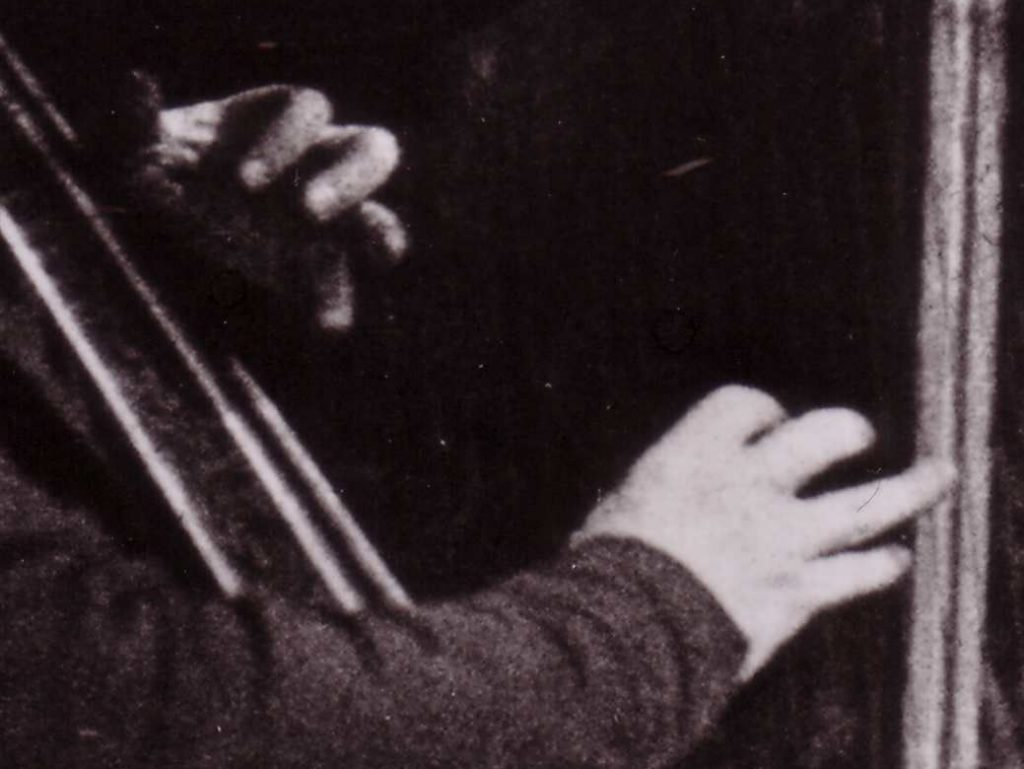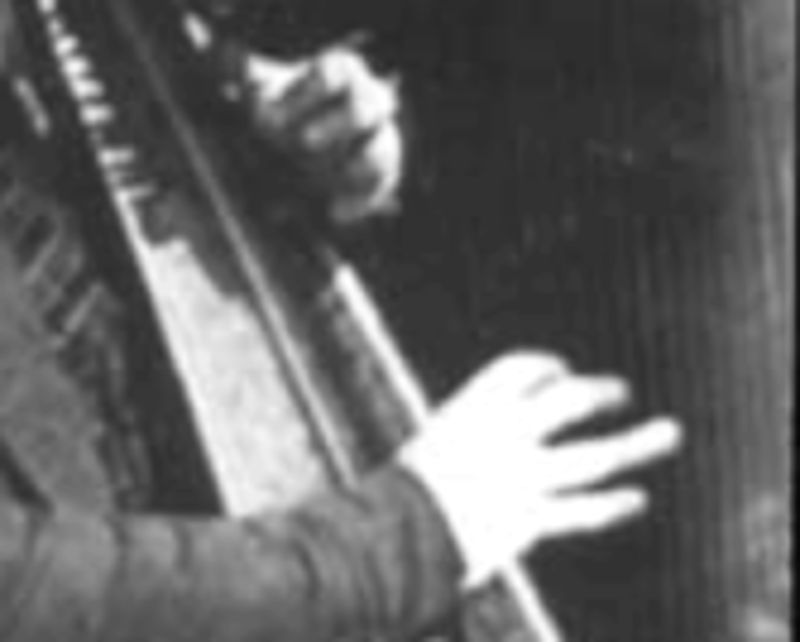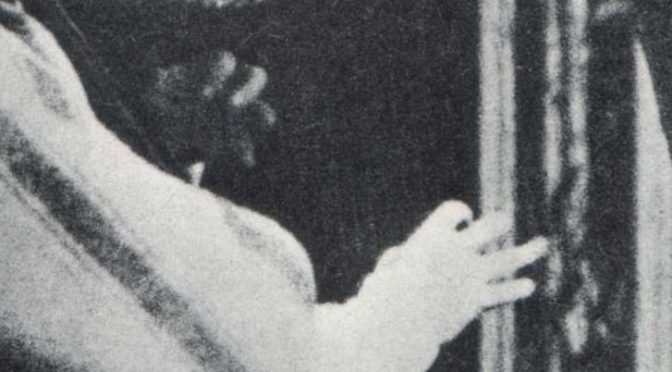Speaking on 10th July, 1849, the Irish harper Patrick Byrne explained to the antiquarian John Bell, the system for tuning the early Irish harp. After starting at na comhluighe, and using a cycle of 5ths to set the middle octave of the harp, he says
Then you sound the G on the violin & B & D, and the octave above which is G which makes a common chord
(By “G on the violin” he is referring to na comhluighe, on g below middle c′)
I never really knew what to make of this offhand comment, wondering if Byrne was testing his tuning by listening to how the 3rd sounded against the octave and 5th, before transferring this tuning up and down the harp by octaves.
But looking at the photographs of him with his hands on the harp, they all show this shape of chord with both hands.



 This last one is interesting showing him with his right hand down at the bottom of the range; not only does this imply that he has a bass without any gaps, but also that he thought it appropriate to place a “common chord” in the deep bass range of the harp as well as higher up. But count the strings; if GG is his lowest note, then he is placed on GG BB D G and g b d′ g′, and you can see his left hand fourth finger is placed on the upper of the two sister strings.
This last one is interesting showing him with his right hand down at the bottom of the range; not only does this imply that he has a bass without any gaps, but also that he thought it appropriate to place a “common chord” in the deep bass range of the harp as well as higher up. But count the strings; if GG is his lowest note, then he is placed on GG BB D G and g b d′ g′, and you can see his left hand fourth finger is placed on the upper of the two sister strings.
As I continue to play my Arthur Ó Néill repertory, playing with the tips of my fingers, I have been listening to the resonance of the harp and noting how different it sounds from the hard percussive clang of the early Irish harp played with long fingernails.
The early Irish harp played with the tips of the fingers has a soft, swelling resonance, a big wooly miasma, like the inharmonic hum of muffled bells. When I played in my usual style, but without nails, at times the texture sounded thin or stark, like playing parallel octaves on a piano, and so I started wondering about filling in the bass intervals more.
Alasdair Codona’s web article, Gaelic Harmony, analysed a number of source notations to understand the harmonic style characteristic of Gaelic harp repertory. His analysis concentrated on two main areas of evidence: the early 17th century lute tablatures, and Edward Bunting’s notation from the playing of Denis O’Hampsey. The lute books are significantly earlier, so if they do reflect harp style, they may be based on fingernail harp playing. And of course, O’Hampsey was a fingernail player. So Alasdair’s conclusions about the typical bass sonorities of parallel octaves and fifths seem to be based on the Gaelic harp played with nails.
I have long said that simpler intervals are better; octave dyads are plenty rich enough for most purposes when playing with nails, and to thicken the texture, the 5th can be added in the middle. But with finger tips, playing the baroque 18th century repertory, this seems bizarrely old-fashioned and un-idiomatic. So I am now experimenting with Byrne’s triad chords to see how they work in my settings of the tunes.
I am still not moving towards functional harmony; I am not interested in chord progressions. But I wonder if using triad chords to enhance the usual Gaelic harp style of harmonising in parallel octaves or stationary drones, is getting us closer to the 18th century sound of the baroque Irish harp played using finger tips instead of long nails.
I notice that one place where Alasdair notes triad chords in a source setting is Bunting’s notation of Banks of Claudy. I tried playing this setting many years ago, early in my harp studies, but dismissed it as unidiomatic, and wondered if it was not a genuine field notation (it is the first item in Bunting’s field notebook, ms29). Alasdair suggests it may be notated from Hugh Higgins, a finger-tip player. I need to go back and look at this setting again, while I have short nails. Will Higgins’s triadic bass suddenly make sense now?

I’ve been wondering if renaissance and medieval Irish and Scottish harp music was more like what’s in the ap Huw ms with big, complex chords.
It’s possible, but I’m not entirely convinced. We have fragmentary hints of what Renaissance Gaelic harp music was like, in Feachain Gléis / Scotts Lamentation, and in the early 17th century Lute manuscripts, and neither of these sources suggest ap Huw style chords. We also have Burns March as a possible model for an older style of Gaelic harp music, and the variations clearly have a very thin texture. You could argue for chords in the ground I suppose.
Also, there are issues of damping and resonance on a medieval Gaelic harp played with the fingernails. That’s an aesthetic consideration that has less weight, but nonetheless, I think its worth considering.
I suspect that the repertory in ap Huw’s mansucript has become that thickly textured because of the sonority of the Welsh harps being used to play it.
I should add, of course, that Patrick Byrne was taught to play the harp by Edward McBride, who was taught the harp by Arthur Ó Néill.
All very interesting, Simon… and I envision you trying out the theories on a Patrick Byrne-style Egan…
• P. Byrne’s maintains an upright treble hand
• strings upon which fingers are placed are not necessarily meant they are to be played
• any idea on how long P. Byrne had to maintain an unmoving pose?
• what do you make of Skarratt’s letter to Bunting (“the naked state”, etc.)?
Thanks Ann.
Of course I’d love to try working with one of the big Egan wire-strung “society” harps. I’m sure there must be one out there in playable (or restorable) condition.
I’m still interested that he consistently placed in this shape. I would not choose that placing if I was asked to put my fingers on the strings and sit still for any length of time. The ring finger is stretched to get that interval of a 3rd between ring and middle finger.
This page suggests exposure from 10 seconds to 10 minutes. Not particularly useful.
http://www.gla.ac.uk/services/specialcollections/collectionsa-z/hilladamson/calotypeprocess/
Skarratt’s letter (C.M Fox, Annals, p.300-301) seems to be talking about the piano arrangements in 1840, praising Bunting for taking “simple” airs and making very sophisticated and fashionable piano arrangements out of them. I don’t know if Skarratt ever saw the draft manuscripts – he may have been comparing Bunting’s piano arrangements with other contemporary prints of Irish music. Either way, I think this is of interest for the subtleties of Bunting’s piano textures and harmonic progressions, rather than of direct relevance to the style and idiom of the 18th (or 19th) century harpers.
My latest post addresses the question of what strings his fingers are on, and I have changed my opinion mentioned above about the placing around na comhluighe. I was misreading / miscounting the strings in the photo.
http://simonchadwick.net/2017/11/knowing-na-comhluighe-not-using.html